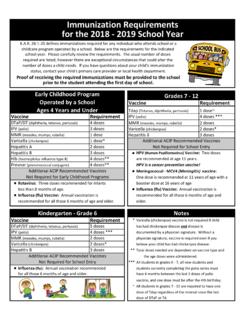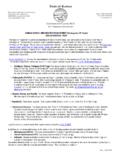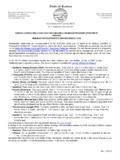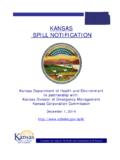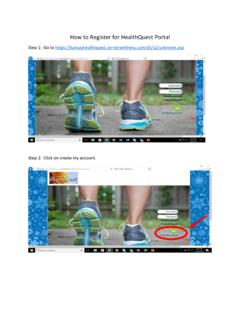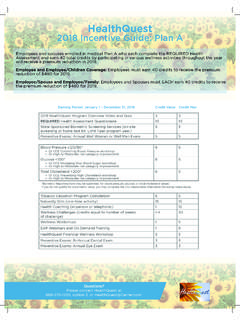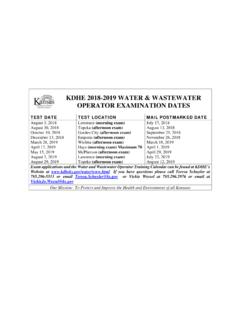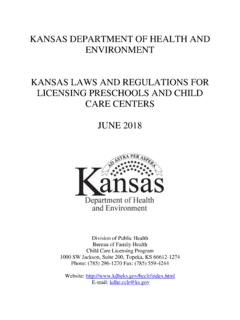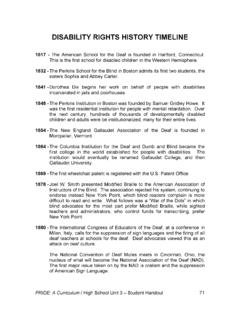Transcription of BUREAU OF ENVIRONMENTAL REMEDIATION/REMEDIAL …
1 BUREAU OF ENVIRONMENTAL REMEDIATION/REMEDIAL section . GUIDELINE. SCOPE OF WORK (SOW). FOR A. CORRECTIVE ACTION PLAN (CAP)/. CORRECTIVE ACTION (CA). BER POLICY#BER-RS-023. PAGES: 6. 1. Introduction The Final Corrective Action Decision (CAD) or Agency Decision Statement (ADS) issued by the Kansas Department of Health and Environment (KDHE) identifies the remedial actions that will be implemented to address risks posed by ENVIRONMENTAL contamination to public health and/or the environment. The Corrective Action Plan (CAP) and Corrective Action (CA) phases facilitate the design, construction and implementation of the remedial actions. KDHE encourages frequent communication and coordination between all key project stakeholders throughout the CAP/CA process to help ensure that the activities satisfy project objectives. As required by the Kansas State Board of Technical Professions, any work products that constitute the practice of geology, engineering, architecture, or surveying should be sealed, signed and dated by a professional licensed by the Board to practice in the State of Kansas.
2 2. Corrective Action Plan The CAP serves as the basis for design and implementation of remedial actions. The level of detail required for a CAP and associated design, contingency, operation and maintenance (O&M), and performance evaluation documentation varies greatly based on the complexity of the proposed remedial actions. For instance, the level of detail necessary to ensure successful implementation of a complicated groundwater extraction and treatment system or electrical resistive heating treatment system far exceeds the design detail necessary for a small isolated soil excavation. The primary objectives of the CAP phase generally include the following: Develop preliminary design for proposed remedial actions;. Develop schedule identifying critical path tasks necessary to implement remedial actions;. Collect supplemental data as necessary to support remedy design and implementation;. Develop detailed design plans and specifications for the remedial actions;. Develop Contingency Plans that identify alternative corrective actions to be implemented in the event of a significant remedy failure; and, Develop or enhance Site Monitoring and Performance Evaluation Plan to monitor the effectiveness of the corrective action.
3 2. CAP Deliverable Requirements Key elements of the CAP and associated documents include: Summary of available site information and investigation results;. Detailed description of the proposed corrective action;. remedial action objectives (RAOs) and remedial goals;. Design specifications and drawing/schematics, including figures and site system engineering layouts ( , process flow diagram, piping and instrumentation diagram, etc.) and engineering design basis;. Cost estimate; and, Detailed working schedule or critical path diagram. The exact elements, content and delivery strategy of the CAP and all associated design documents will be determined by KDHE in consultation with the project stakeholders. Typically, a preliminary (10%) design package will include a preliminary construction schedule, specifications outline, preliminary drawings, design basis, and a detailed statement of how all applicable or relevant and appropriate requirements (ARARs) will be met. The preliminary design should also incorporate a data acquisition plan to collect any data necessary to facilitate remedial design and/or implementation.
4 An intermediate (30-50%) design package will include an updated construction schedule, preliminary specifications, intermediate drawings, updated design basis report, updated ARARs evaluation, and findings of any data acquisition activities. A pre-final/final (90-100%) design package will include further updates of the above- mentioned items plus pre-final/final design specifications/drawings and design basis report/design analysis. Unless submitted separately, the CAP/Final Design Package should address O&M and performance monitoring needs as well as shakedown testing and startup procedures. There may also be a need for development of a Construction Quality Assurance Plan and a separate Health and Safety Plan for CA implementation. Site Monitoring and Performance Evaluation Plan The Site Monitoring and Performance Evaluation (SMPE) Plan presents the activities planned to evaluate the short-term and long-term performance of the remedial action relative to project remedial action objectives and goals.
5 The site monitoring and performance evaluation data serve as the basis for whether or not contingency implementation is necessary. Key elements of the SMPE Plan include: remedial action objectives and remedial goals;. Summary of the remedial system operations that will be evaluated and identification of 3. criteria that will be used to evaluate system performance;. Frequency, methods, and rationale for site monitoring;. Description of the ENVIRONMENTAL media to be sampled (groundwater, surface water, soil, soil vapor, indoor air, etc.);. Description of quality assurance/quality control (QA/QC) considerations;. Identification of institutional controls that will be inspected/monitored;. Plan for evaluating changes in land use of impacted areas that may alter the effectiveness of the corrective action; and, Description of reporting methods, format, and frequency. Description of contingency trigger criteria ( , asymptotic mass removal/product recovery rates, sentinel monitoring thresholds, etc.)
6 O&M Plan Whether included in the CAP/Final Design Package described above or prepared separately, an O&M Plan must be submitted for KDHE review and approval. To facilitate preparation of an O&M Plan, please refer to available ENVIRONMENTAL Protection Agency (EPA) guidance entitled Operation and Maintenance in the Superfund Program (OSWER ;. EPA540-F-01-004; May 2001). The intent is for any operator to be able to use the O&M Plan and clearly understand O&M procedures to be followed, documentation requirements and corrective measures to be taken dependent upon anticipated circumstances or upset conditions. Proper planning and advance contingencies are appropriate considerations to minimize remedial system downtime. Contingency Plans The level of detail needed upfront related to contingency implementation is directly correlated to the reliability of the proposed corrective action. KDHE may not require upfront contingency identification in some cases where the proposed remedy has little chance of failure ( , small soil excavations, etc.)
7 However, for complicated remedial actions or for remedies that incorporate innovative or unproven remedial technologies, significant upfront contingency planning may be necessary. KDHE encourages discussions regarding the scope of contingency planning requirements throughout the CAP process. At the point KDHE determines contingency implementation is likely or eminent, based on contingency triggers identified in the SMPE Plan or other changes in site conditions, KDHE will request development of a Contingency Plan. Contingency Plans are generally expected to meet the requirements for a CAP; however, the scope of the Contingency Plan may be more focused depending on the nature of the proposed contingency action. 3. Corrective Action The Corrective Action phase encompasses all activities associated with remedy implementation, operation and maintenance, and site monitoring and performance evaluation. As with the CAP. phase, the level of detail necessary to satisfy project needs is directly related to the complexity of the site and proposed remedy.
8 4. The primary objectives of the CA phase are described as follows: Implement the CAP as approved by KDHE;. Operate and maintain the corrective action system;. Evaluate and monitor the performance of the corrective action as described in the approved SMPE Plan;. Implement the approved contingency, as needed; and, Document all activities performed pursuant to the corrective action. CA Implementation and Reporting The CA selected for the site shall be implemented in accord with the KDHE-approved CAP/Final Design Package and schedule. Depending on the complexity and duration of the corrective action effort, periodic interim status reports may be necessary ( , weekly, monthly, etc.) documenting CA activities. An Interim CA Report that documents the corrective action constructed or implemented at the site shall be submitted to KDHE for review and approval. The Interim CA Report should include a system startup report and as built drawings of the remedial system. O&M and Site and Performance Evaluation Monitoring activities are required until site remedial action objectives and goals are attained.
9 Once these goals are attained, a Final CA. Report shall be submitted which describes all CA activities and documents that the CA phase is complete. In some cases, where remedial action objectives are attained at the completion of construction activities, the Interim CA Report may be combined with the Final CA Report. Site Monitoring and Performance Evaluation Reporting The KDHE-approved SMPE Plan serves as the basis for evaluating the effectiveness of the remedial action. Following periodic monitoring and performance evaluation activities, SMPE. Reports must be submitted to KDHE. The SMPE Reports should contain all of the information and data as described within the SMPE Plan, including a narrative description and/or graphic evaluation of the effectiveness of the corrective action as compared to the site-specific RAOs or remedial goals. An outline for SMPE Reports is provided as an attachment. If the site monitoring and performance evaluation program demonstrates that the implemented corrective actions are incapable of achieving corrective action goals within a reasonable timeframe as determined by KDHE, the SMPE Report should recommend modifications to the existing remedial system that will enable the system to achieve the remedial goals and/or propose contingency implementation.
10 KDHE must be notified within seven days of any significant changes that could adversely affect the performance of the corrective action. 5. 4. REFERENCES. Comprehensive ENVIRONMENTAL Response, Compensation, and Liability Act of 1980 (42 . 9601 et seq. as amended by the Superfund Amendments and Reauthorization Act). National Oil and Hazardous Substances Pollution Contingency Plan (40 CFR 300). EPA, 2002, Guidance for Quality Assurance Project Plans (QA/G-5), EPA 240-R-02-009, available online at , ENVIRONMENTAL Protection Agency, Office of ENVIRONMENTAL Information, Washington DC, December. EPA, 2001, Operation and Maintenance in the Superfund Program, EPA540-F-01-004, ENVIRONMENTAL Protection Agency, Office of Solid Waste and Emergency Response, Washington DC, May. EPA, 2001, EPA Requirements for Quality Assurance Project Plans (QA/R-5), EPA-240-B-01- 003, available online at , ENVIRONMENTAL Protection Agency, Office of ENVIRONMENTAL Information, Washington DC, March. EPA, 1995, remedial Design/ remedial Action Handbook, EPA 540/R-95/059, ENVIRONMENTAL Protection Agency, Office of Emergency and remedial Response, Washington DC, June.
